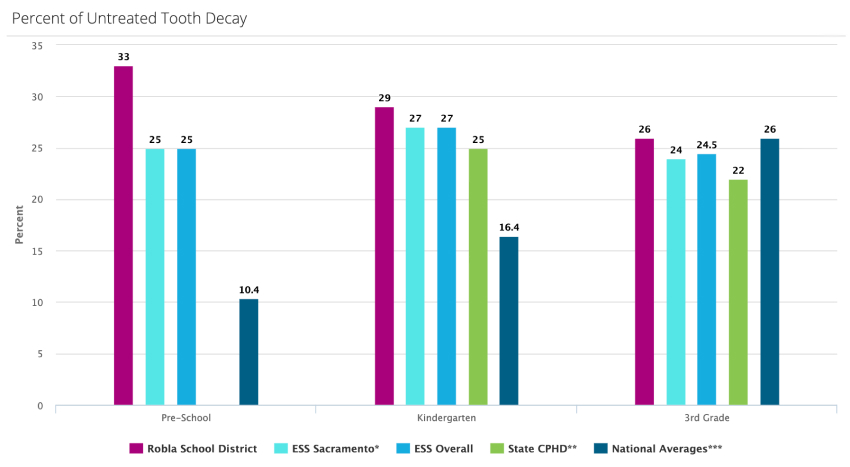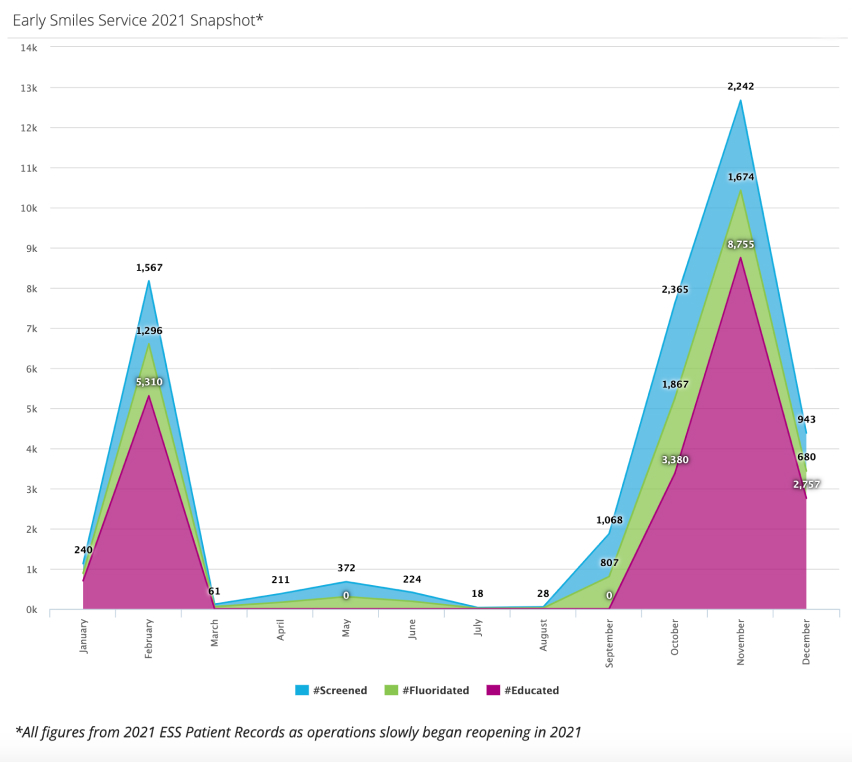$2,477,014 Raised
50%
Our Goal: $5,000,000
Donate now: $1 donated brings $107 of oral health education and services to public school students
Early Smiles Stories
California’s ONLY comprehensive in-school oral healthcare program for underserved students and schools
Early Smiles is an innovative public-private partnership minimizing the dental disease burden among children and families.
Early Smiles' work in Sacramento County is completely funded through California's Dental Managed Care (DMC) program's health plans: Liberty Dental, Health Net, and Access Dental.
The future of this funding is in question.
Our current budget of over $1 million allows us to offer Early Smiles services to about 35% of elementary school students across 11 Sacramento school districts. Their needs are expanding every year. We must look ahead to grow our budget and diversify funding sources to meet Early Smiles' goal of serving 4 million students in need across each of California's Title 1 schools.
Early Smiles Annual Statistical Profile
$1 of program investment = $107 in oral health education, screening, preventative care, and navigation to professional dental providers delivered to each student right at school.
11 School Districts and 200+ Schools Served
45,000 Students Educated on Proper Oral Healthcare
27,000 Average Student Screenings
60% Fluoride Varnish Rate
50+ Community Events
4 Family Resource Centers Served
Pandemic service to 12,000+ children and family members
The Problem
Nationwide about 1 in 5 children (20%) ages 5-11 are experiencing untreated tooth decay (1). In California, that percentage is closer to 1 in 4 (at 22%) (2) and poor students of color pay the highest price. Medi-Cal coverage offers access to care but utilization rates are low because of long appointment times, transportation issues, and a limited number of participating dentists close to families. Early Smiles knows that we must start early and serve kids at schools to address immediate issues and ensure proper oral health care for the future.
California results echo the national outcomes. To learn more about the national results, see NIHCM Oral Health & Health Equity Infographic.
Impacts of Untreated Tooth Decay
COH research, confirmed by national results, shows that tooth decay hurts children now and later. Children experiencing untreated cavities also suffer physically (pain, infection and later increased risk of gum disease, diabetes, oral cancers, and heart disease), psychologically (low self-esteem, isolation, and depression) and academically (chronic absenteeism, classroom disengagement, low self-confidence). Negative results burden families and follow kids into adulthood with significantly lower incomes, fewer employment opportunities, and continuing struggles with self-esteem (3,4).
Saving Smiles and Money
COH data show a significant (4.9%) decrease in the rates of decay in children who have been previously educated, screened, treated, and referred for treatment by the Early Smiles team. Nationally, data show that fluoride treatments, alone, can decrease 33% of cavities in primary teeth (3). Early oral health education and prevention create lasting positive behaviors in children and their families. They also help the public. Annually, our Nation spends an average of $124 billion on costs related to dental care with another $45 billion lost in productivity due to unplanned dental visits (3).
The following benchmarks are based on Early Smiles average screening and service numbers paired with publicly available research on public/private expenses. The Early Smiles team saves individuals, families, schools and taxpayers a projected $47 million annually in Sacramento alone.
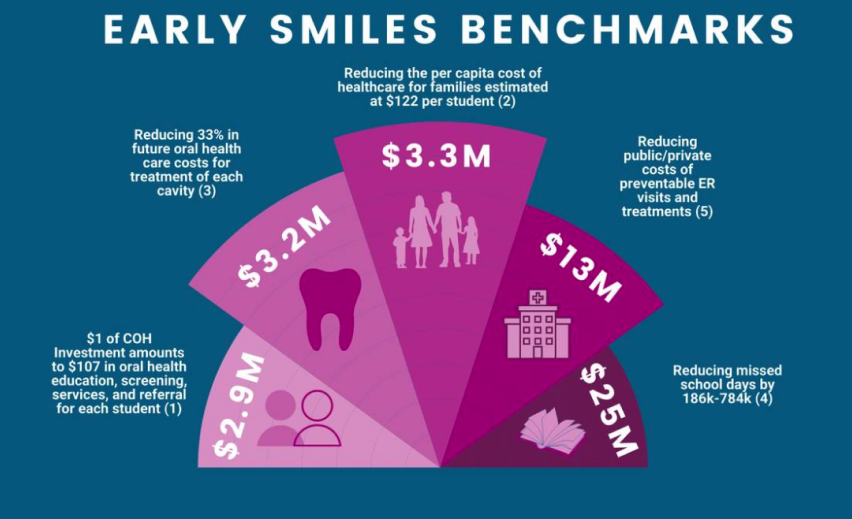
(1 & 2) California Dept of Healthcare Services; 2019 service population of 27,000 students served by ESS (3) California Dept of Healthcare Services, CDC Division of Oral Health (4) National Children's Oral Health Survey, Vujicic (2016), Casamassimo (2009), Pourat (2009), CA Oral Health Technical Assistance Center, Fay (2018). (5) California Department of Public Health, Barbara Aved Associates (2015), The Sacramento Bee, Kindergarten Oral Health Assessment Results
Early Smiles Coverage
Areas of Expansion
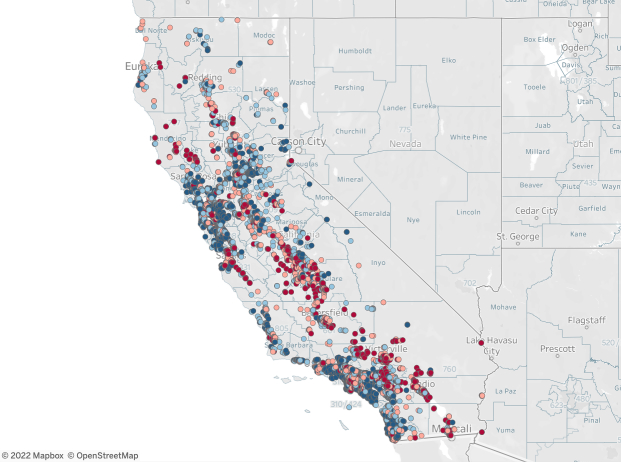
About the Data
The 1-4 scale represents 1-lowest need to 4-highest need schools.

Demographics
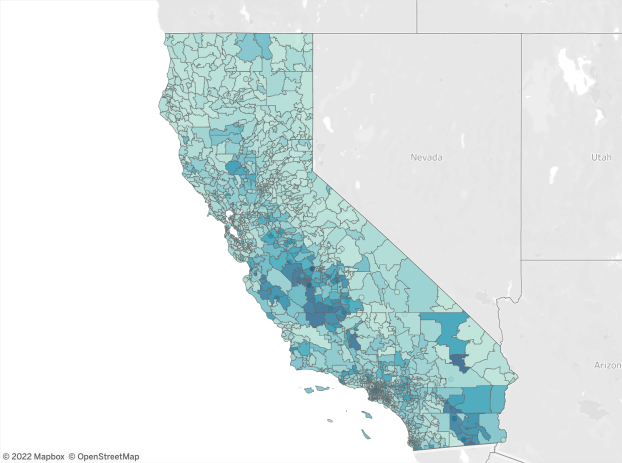
About the Data
Use the filter to switch between Black or African American alone, Hispanic or Latino, and Percent of Households Speaking Spanish categories. These demographic categories are associated with untreated tooth decay.
Poverty
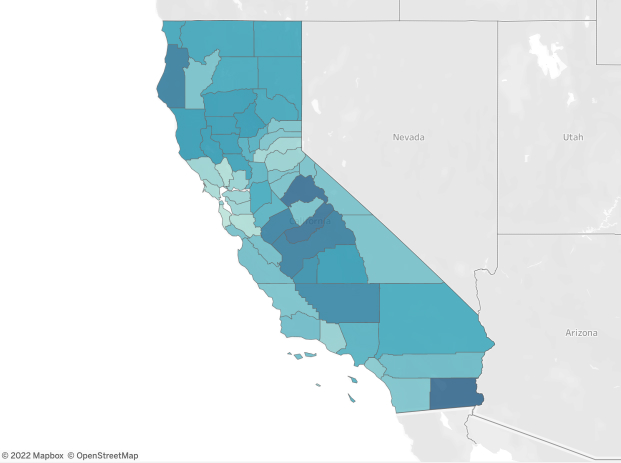
About the Data
The heat map displays the poverty rate (percent) by country.
Source: https://www.ppic.org/interactive/california-poverty-by-county-and-legislative-district/
Service Areas & Needs
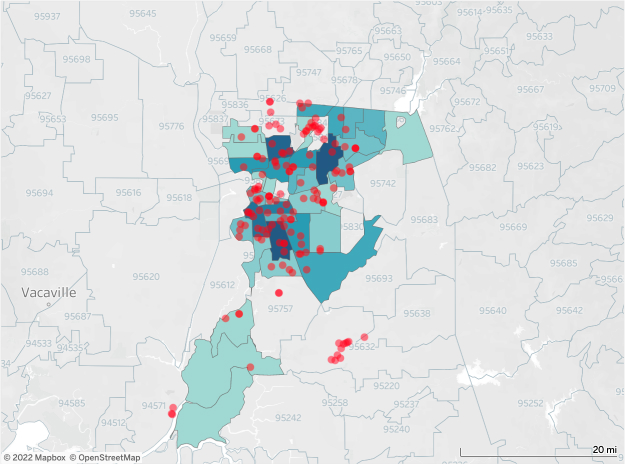
About the Data
The heat map displays a count of Early Smiles programs by zip code.
The points represent Title 1 schools not being served by Early Smiles.
Explore Early Smiles Service Areas by the blue map shading above, which indicates the count of programs in a certain zip code. The red dots represent currently unserved schools.
The Areas for Expansion tab is from California School Based Health Alliance (CSBHA), Student Health Index, 2021, https://www.schoolhealthcenters.org/school-based-health/student-health-index. The Need Score Quartile shown above is made up of 12 indicators based on current population characteristics and health care access. CSBHA created an index to assign need scores (ranging from "1" representing lowest need to "4" indicating highest need) by measuring each of the indicators for every public school in the dataset. For more background on methods and applications visit https://www.schoolhealthcenters.org/school-based-health/student-health-index/methodology.
The Demographics tab show several variables: Total population: Black or African American Alone: 2015-2019 American Community Survey; Total population: Hispanic or Latino: 2015-2019 American Community Survey; Percent Speaking Spanish: 2015-2019 American Community Survey; Percent of households who speak Spanish by zip code, scale is 0-1.
The Poverty tab show several poverty variables: Poverty Rate (percent), Child Poverty (percent), and California Poverty Measure (CPM) Poverty Threshold. Source: https://www.ppic.org/interactive/california-poverty-by-county-and-legislative-district/
Early Smiles Impact
Over the 3 year period (2018-20) under analysis, Early Smiles had the opportunity to educate, screen, offer fluoride varnish treatments to 37,675 students. They provided dental home referrals to two-thirds of a group of 4,749 student participants. Analysis of this group indicates a statistically significant (4.9%) reduction in untreated tooth decay as documented in later screenings.
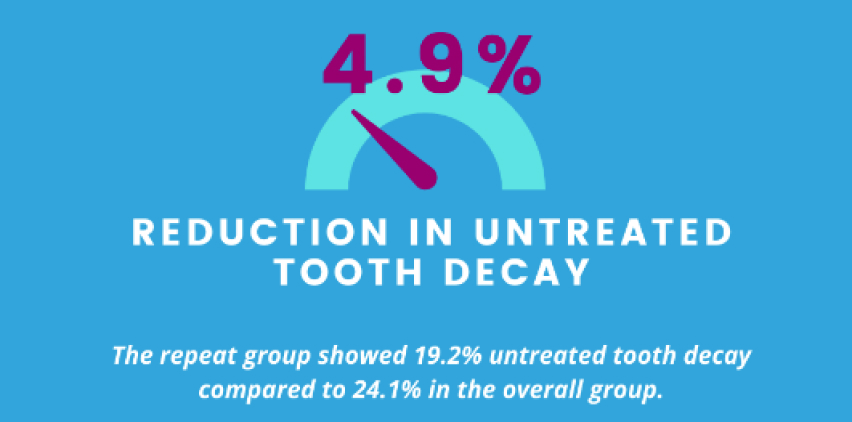
Testimonials of Need
Between April and June, 2021 the Center for Oral Health conducted primary research with 10 partnering schools and 80 parents/guardians of children served. School health leaders and parents agree that Early Smiles is a vital school support service that benefits students, families, health administrators, teachers and our school districts. Our data support national level findings related to the social, geographic, and economic determinants of oral health. Children of color, living in poverty, and/or in isolated rural areas are disproportionately affected. COH research results reveal significant gaps inside individual school districts across Sacramento County. Below are some of the high-level trends emerging from District health leader and parent feedback:
- Early Smiles Sacramento is the first, and many times, only dental care option for underserved students;
- Low awareness of the importance of good oral healthcare is pervasive among parents and their children;
- Missed school days, inattention due to pain, and lowered self-esteem are the direct results of untreated tooth decay in children;
- Emergency Room (ER) care and/or full tooth removal is a common family approach to serious (though preventable) dental issues - particularly in dental deserts;
- Sacramento City USD is a large and overwhelmed school system with a history of poor external partnerships and a well-documented need for integrated medical/dental/vision systems;
- The area surrounding Robla and Archoe school districts are located in healthcare/dental deserts. Poverty is high, population low and widely dispersed. In these areas, expensive ER care is, many times, the only local option for parents and their children seeking immediate care.









Early Oral Healthcare Starts at School
Our school health partners and parents regularly tell us about the importance of Early Smiles at school. Our team removes critical barriers to access by meeting students where they are. We teach them about healthy oral care habits that stay with them as they grow. Early screening and fluoride varnish treatments are essential preventative services for underserved students. Students in need of immediate dental treatment benefit from our careful referral and routing system to ensure are seen by a local dentist that accepts Medi-Cal patients without the 20-30 day wait.
Parent Feedback
Early Smiles parents place a high priority on early oral health care for their children—92% of parents stated early oral health care was extremely important. At the same time, accessing Medi-Cal benefits can be extremely difficult for our families, mainly due to the issues of delayed appointments, affordability, and easy access to a local provider who accepts Medi-Cal. See survey responses below for additional insights:
Use the below dashboard to filter by survey question (check box at right) and to explore the parent answers by hovering over the bars and circles in the charts.
Case Study: Robla School District, a Dental Desert
Robla has significantly higher rates of documented decay than most other districts in the program. It has also been described by school district health officials as a medical and dental provider “desert” wherein few resources exist for preventative and treatment of oral health issues for a poor, largely non-English speaking population. ER care for preventable dental emergencies is common and overburdened families must drive great distances to see dentists and other health providers.


As the district’s school health official observed, “untreated cavities and oral health care is a big problem out here. Robla is in an economically depressed area with a high immigrant population…. There are individual apartments with some rural, single houses. A few families doubled up under one roof. The busing system is poor, no library, a single grocery store, and few social services. We are a health care and dental care desert out here. It is just too far to drive to clinics so families typically go to the emergency room for any major dental or health problem.”
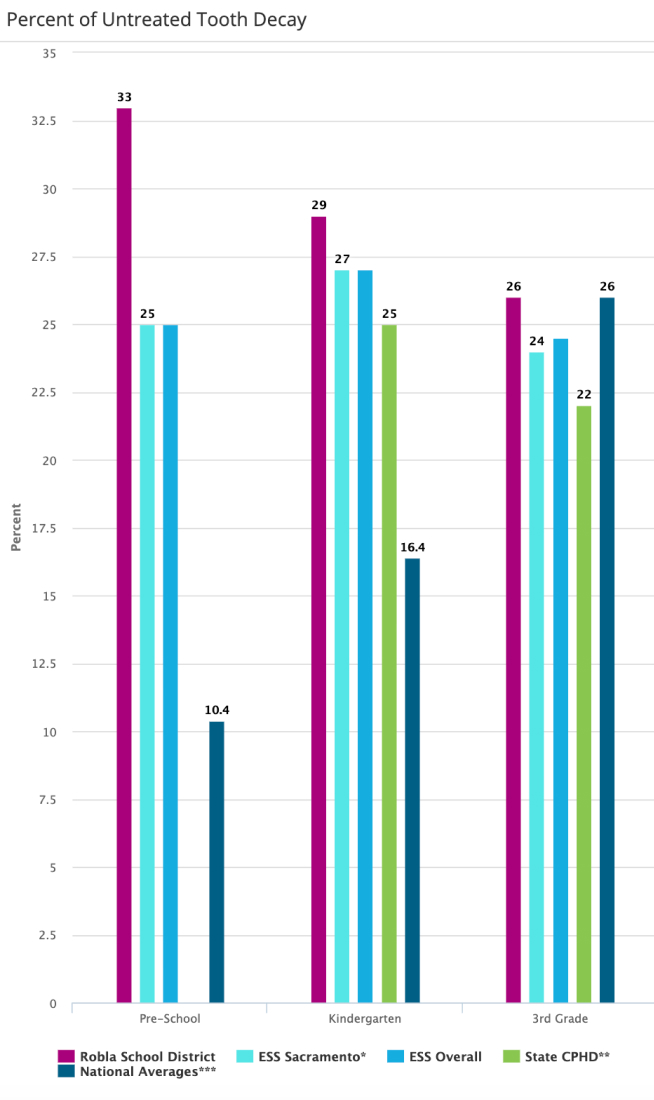
Pandemic Service
At the start of 2021, California Schools and families were still in lock-down. Early Smiles responded by continuing to offer drive-thru screening with fluoride treatments, referrals and consultations to entire families in need. Our screening numbers rose steadily with the availability of COVID vaccines - falling temporarily with the Delta Variant between July and August. By September, the Early Smiles team was back in schools, delivering outstanding service to large numbers of elementary schoolers. By December, we reached nearly 15,000 with education, screened 7,612 students, and saw a significant (20%) increase in our fluoride treatment rates.
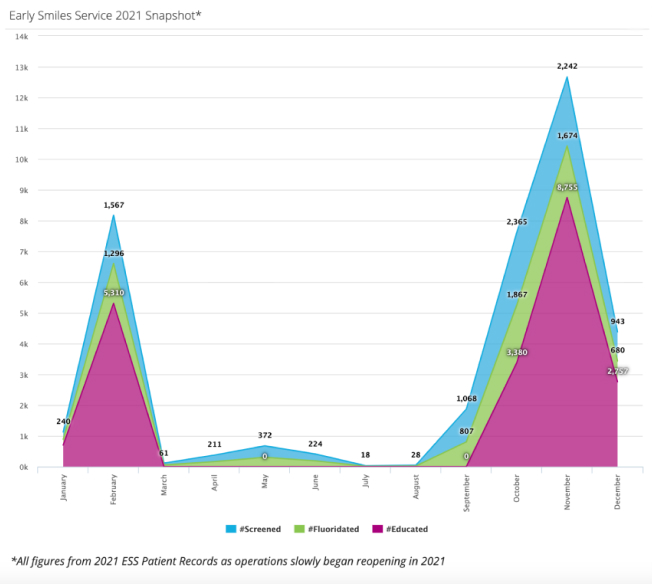
Case Study: Oral Healthcare during COVID
Looking back, Early Smiles provided ongoing service to kids and families in need during quarantine. Throughout 2020, the team (following strict CDC Covid safety measures) provided drive-thru services to underserved children, families, and guardians at various sites throughout 11 Sacramento school districts. Early Smiles partnered closely with schools to seamlessly integrate oral health services along with meal pick-up and other district supports. The team opened access to oral health by offering education, screening, fluoride treatments, and navigation services to everyone in the car (including youth, adolescents, and adults). At the end of the visit, families took home free oral health care kits to support healthy habits at home. Patients needing emergency services were immediately referred and routed to professional providers.
In May of 2020, Early Smiles began offering oral tele-health consultation and education to students and parents via Zoom as part of their regular classroom instruction. They offered one-on-one support, answering parent questions. The team served more than 7,000 patients with safe oral health screenings. These services continue at numerous vaccination sites throughout the Sacramento City Unified School District.
References
- CDC.gov data reported by the National Association of Chronic Disease Directors, Planning Document (FY 2021-22)
- California Smile Survey (2018-19)
- CDC.gov (2018)
- American Dental Association (2020)

